
NEW NETS WITH MORE
BUILT-IN POSTS
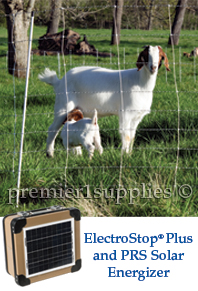
ElectroStop® Plus
We noticed that several “net” users have added extra posts to their nets. We understand! We’ve also encountered netting situations that require additional posts to effectively fence in/out livestock, poultry and predators.
So we asked our net manufacturer to supply us with nets that have more posts per length of netting. We call them "Plus" nets.
Advantages:
| 1. |
Reduced sagging between posts. |
| 2. |
Better fencing for curves/corners and across dips/hills. |
Negatives:
| 1. |
Same length of net weighs more. |
| 2. |
Same length of net costs more — but less than the total cost when users add "farmstore" nonstandard posts to Premier's electrified netting. |
PRS Solar Energizers
Which PRS unit is right for you?
The PRS units from Premier range from .5 joule to 2 joules, which is more than enough for most temporary fencing situations.
The size, in pulse energy output, depends almost entirely on the weed contact that will occur on the fence. Contact Premier or call 800-282-6631 to speak with one of our fence consultants to help you determine the best energizer for your needs. You can also view our energizer comparison charts online or in Premier's fencing catalog to help in choosing an energizer.
How to get your PRS solar energizer ready for fencing season. View our video (below).
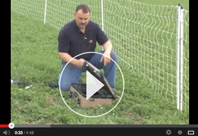
For an easy way to see if your fence has at least 3000v running through it, check out our new BlitzLight!
PREMIER TIP
Training Goats to Electrified Netting
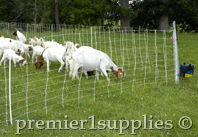
For goats, electrified netting is only a pain barrier, not a physical barrier. Netting must always be properly electrified (using our 20B energizer in photo above) for it to properly function. A 3000v pulse is the minimum voltage for containing goats. A determined goat can and will get through netting, though not without receiving several shocks.
Goats must be trained to electrified netting before field use. To do this, set up the netting and electrify it within a corral or other small fenced-in area that will prevent the goats from getting out in case they jump through the net when they're first shocked.
For the first several hours, watch the goats interact with the net to make sure no entanglements occur. Goats are curious animals, and soon each goat will test the fence or watch its flock mates test the fence.
Once the animals are trained, electrified netting can be effectively used in the field. Check the fence 2 to 3 times a day during initial use and at least daily once the flock has settled in.
Sara McArtor, Premier Product Consultant
|
 |
 |
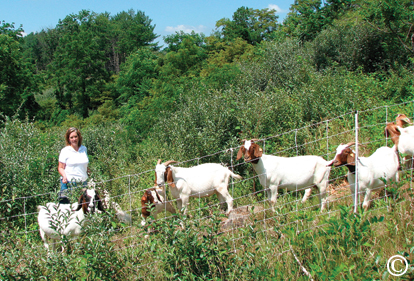 Boer goats used for forest reclamation — photos by Clay and Linda Trainum from the state of Virginia (see their article below). They work with their local Soil and Water Conservation District to control invasive plants with Boer goats.
Boer goats used for forest reclamation — photos by Clay and Linda Trainum from the state of Virginia (see their article below). They work with their local Soil and Water Conservation District to control invasive plants with Boer goats.
Grazing goats with netting
A piece of ground that is full of brush and bramble might be excellent grazing for goats.
Premier uses netting to fence through a thicket on our farm. Goats prefer this feed source over any other forage we offer.
However, that same thicket is one of the hardest to fence. It's difficult hauling standard posts up and down hills and through thick undergrowth, let alone pounding them in. This is where electrified netting proves its worth. No posts to pound or wire to stretch. Netting is easy to carry, quick to install and proven effective at preventing curious goats from escaping.
"Plus" versions with extra posts are even better for adapting to "goat ground" than regular netting.
VIP ARTICLE
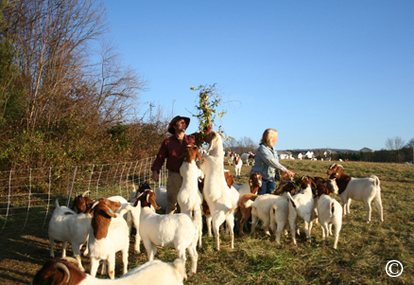 The Trainums' Boer goats are voracious browsers and can reach foliage up to 7 feet off the ground. Pictured here in a field in a Waynesboro city park, the goats are in unusual pasture habitat. They prefer thick, bushy forage like that pictured on the left side of the photo.
The Trainums' Boer goats are voracious browsers and can reach foliage up to 7 feet off the ground. Pictured here in a field in a Waynesboro city park, the goats are in unusual pasture habitat. They prefer thick, bushy forage like that pictured on the left side of the photo.
Invasive Plants: Major Problem Alleviated Naturally
by Clay & Linda Trainum
www.autumnolivefarms.com
Controlling non-native plants are an ongoing, major problem in Virginia. Unfortunately, two common methods used to control invasive plants have their own set of problems. The first is herbicidal spraying, which requires significant amounts of chemicals and multiple treatments. Success can be achieved with this method but the negative environmental impact can be devastating to local and regional watersheds. The other method is constant mowing or mechanical land clearing, both of which cause soil disruption and use large amounts of labor as well as foreign oil and gasoline.
That's why we're pleased to offer our goats as an all-natural alternative to herbicides.
Our Boer Bok provide "biological control" of invasive plant species on locations throughout Virginia, including public places such as the Frontier Culture Museum and Coyner Springs Park. We're proud to be part of a pilot land reclamation project sponsored by the Shenandoah Resource Conservation and Development Council (RC&D), in partnership with the Headwaters Soil and Water Conservation District, to demonstrate the effectiveness of this all-natural clearing and study the additional soil-building benefits provided naturally.
Soil Enhancement
Grazing Boer Bok on pasture does more than effectively clear the land. The animals also build the quality, amount and fertility of soil. As the goats graze, they deposit small amounts of urea and pelletized plant waste. This natural process builds soil to protect from erosion and enhance overall soil production. As a result, native plants and grasses compete more favorably against the invasive plants that thrive in poor soil.
Contact Clay at clayfordt@gmail.com or 540.447.6958 if you are interested in having our goats help manage your land. He will be glad to come and look at your problem and work out a solution that works best for you.
READ MORE » For more about the Trainums and their Boer goats, read the article published about them by Lancaster Farming magazine (the article is hosted on the Trainum Family's website):
Augusta County Farm Couple Raises Meat Goats on Diet of Unwanted Plants
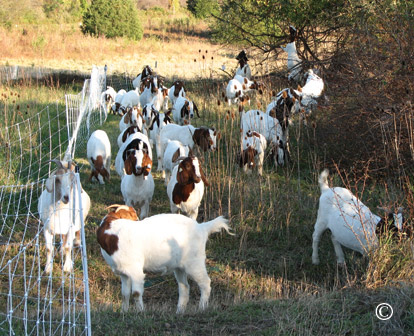 Boer goats used for forest reclamation. Clay and Linda work with their local Soil and Water Conservation District to control invasive plant species with Boer Bok goats. Using Premier's ElectroStop®.
Boer goats used for forest reclamation. Clay and Linda work with their local Soil and Water Conservation District to control invasive plant species with Boer Bok goats. Using Premier's ElectroStop®.
CHECK YOUR PASTURES
Toxic Plants and the Common Caprine
Cornell University, Department of Animal Science
If you're planning on grazing goats on unfamiliar pasture, take a walk-through, checking for any plant species that may give your goats something more than an upset stomach. Also, be sure to check the fence line for any plants within their reach on the other side.
The following link takes you to Cornell University's list of plants toxic to goats. (You'll also find lists of plants toxic to other livestock on this site.) Familiarize yourself with the plants on the list and remove them from your pastures before letting in the animals to graze.
READ MORE »
|
|